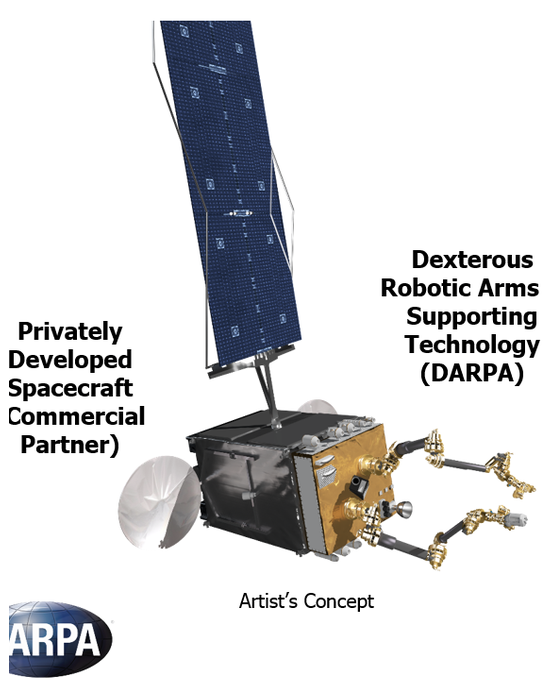The reality is that with satellites rotating in space, there will be a hiccup or a breakdown of sorts that will either render the satellite useless and a hazard...what to do? DARPA has issued a public-public partnership for In-orbit Robotics Servicing of Geosynchronous Satellites servicing for both commercial and military sats.
The Defense Advanced Research Projects Agency (DARPA) announcement of a Robotics Servicing of Geosynchronous Satellites (RSGS) program in March is an important step towards extending the productivity of America’s space assets. DARPA is looking for a public-private partnership with the commercial space industry that would make robotic in-orbit servicing available to both military and commercial geosynchronous satellite owners.

The concept of servicing satellites in space has been studied and talked about for decades. The up-front investment in developing such a technology has been a barrier to commercial industry getting into the business of servicing and refueling GEO spacecraft. But now with government funding, the concept is moving closer to reality, with DARPA combining input from industry, government, and academia in its RSGS program.
Once launched, RSGS would offer means for lengthening the life of a satellite by refueling or repairing it and installing technological updates while the satellite is in orbit—even removing defunct satellites by guiding them to graveyard orbit beyond the GEO arc that would forestall adding debris to the space environment.
Such in-orbit servicing would add to the resiliency of DoD’s space capacity. It will also provide another opportunity for commercial partners to provide needed support for government satellite operations, as DARPA envisions the service vehicle being launched on a commercial satellite and operated from the ground by a commercial partner. The servicing tool, DARPA’s Front-end Robotics Enabling Near-term Demonstration (FREND), is currently being tested at the Navy’s Research Laboratory Spacecraft Engineering Department.
Intelsat General Corporation, with regularly scheduled launches into geostationary orbit is suited to partner with DARPA in this effort. DARPA will provide the robotics technology, its general expertise and a government-provided launch. The commercial partner will potentially contribute the satellite to carry the robotic payload, integration of the payload onto it, and the mission operations center and staff. When this new service is available, this effort could dramatically extend the operational lifecycle of current satellites and lower the risk and cost of operating satellites in GEO.
On-orbit satellite maintenance is a logical extension of the support the private industry has always provided the military. The DoD has embarked on a Third Offset Strategy to develop a long-term technology edge that will help keep the United States militarily dominant. On-orbit servicing can contribute to the Third Offset, and be a reliable, experienced commercial partner handling the day-to-day operation of satellite platforms for the government. And it’s the right partnership to finally make satellite “house calls in space” a reality.

